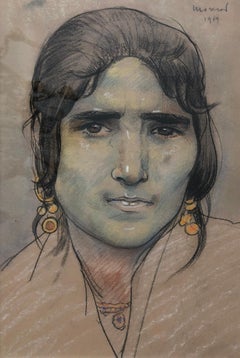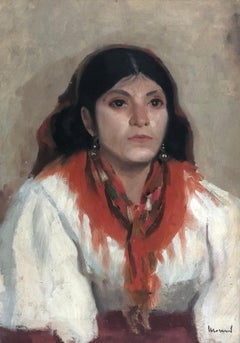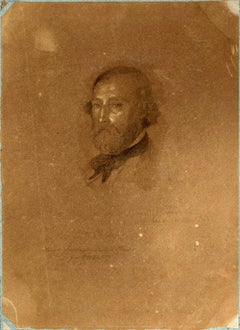Édouard Morerod Art
Swiss, 1879-1919
Édouard Henri Louis Morerod, born May 16, 1879 in Aigle and died July 22, 1919 in Lausanne, was a painter from Vaud.
When his father died in 1889, the family moved to Lausanne, where the boy attended the Cantonal College. In 1891, when the mother died, Édouard and his sister were placed in a boarding school. The young man studied in Neuchâtel, at the Latin College, then at the cantonal gymnasium (from 1895), but passed his baccalaureate in Lausanne (1897). Demobilized from his military service (Bern) in 1899, Édouard Morerod began studying at the School of Fine Arts in Munich (January and February 1900 only), then left for Germany, Sweden and Norway. After a visit to Ibsen (in Oslo), he begins to write his diary. During a stay in Paris (1900), he met Steinlen, who would influence his work. In 1901, Édouard Morerod spent three months in Lotarevo (Russia), then discovered the country (Moscow, Tsaritzen, Georgia, Crimea). Before returning to Lausanne, where his first exhibition (Grenette) will be held, he stops in Constantinople, Athens and Rome.
From 1903, Édouard Morerod stayed several times in Spain (Andalusia (Seville), Toledo). Success finally crowned his work: the Luxembourg Museum, the City of Paris and the Museum of Fine Arts in Neuchâtel sent him commissions. He exhibited at the Indépendants in 1903 and was a member of the jury for the Salon d'Automne in 1907. In Paris (1910), he met the Pulliéran painter Marius Borgeaud; he always meets Félix Vallotton, Alice Bailly and Francillon. Pierre Louÿs entrusts him with the artistic direction of his last play, La Femme et le Pantin, as well as the creation of the poster and the costumes (1910).
After visits to several European cities, Édouard Morerod went to Leysin to treat himself from tuberculosis (1915), where he painted a few portraits. On December 6, 1915, his exhibition of pastels and drawings brought back from Spain opened in Lausanne, which Paul Vallotton presented in the salons of the Bernheim-Jeune gallery. While living surrounded by artists in Paris, the Beaux-Arts in Lausanne bought him a Pastora. In 1918, Édouard Morerod painted the sister of the poet Supervielle, Madame de Lasala.
Édouard Morerod went to Seville in 1919, but his state of health forced him to return to Switzerland. After a brief stay in Leysin, he had to go back down to Lausanne, where he died on July 22, 1919. His body was buried in the Montoie cemetery. In 1921, the Galerie Moos in Geneva and the Musée Arlaud each devoted a retrospective to him.to
1
1
Overall Width
to
Overall Height
to
2
1
2
2
2
2
2
1
1
1
1
1
1
2
9,478
2,688
1,375
1,361
2
2
Artist: Édouard Morerod
Native American woman portrait
By Édouard Morerod
Located in Genève, GE
Work on paper
Molded frame in gilded wood with glass pane
61 x 51 x 6.5 cm
Category
1910s Édouard Morerod Art
Materials
Charcoal, Crayon, Pastel
Spanish girl with headscarf
By Édouard Morerod
Located in Genève, GE
Work on cardboard
Beige wooden frame
56.5 x 43.5 x 4 cm
Category
Early 20th Century Édouard Morerod Art
Materials
Oil
Related Items
10-11-9 - 21st Century, Contemporary, Nude Painting, Oil on Canvas
By Montse Valdés
Located in Barcelona, Catalonia
“I paint the human figure and explore further till I reach the Beauty of Being, the Soul.. the part of Human Being where everything is in total Serenity, Goodness and Harmony, where ...
Category
21st Century and Contemporary Contemporary Édouard Morerod Art
Materials
Canvas, Oil
$17,508 Sale Price
20% Off
H 51.19 in W 76.78 in
Portrait Gustav Wilhelm Palm - 19th Century Pencil and Pastel on Paper
Located in Stockholm, SE
Portrait of Gustaf Wilhelm Palm (1810–1890) by Lorenz Frølich (1820-1908)
Signed with monogram and dated May 1849. Pencil and pastel on paper. 29.5 × 21 cm.
This portrait of the Swed...
Category
1840s Naturalistic Édouard Morerod Art
Materials
Paper, Pastel, Carbon Pencil
$531
H 11.62 in W 8.27 in D 0.4 in
Early 20th century Art Deco Male nude oil painting of Narcissus
By George Frederick Hinchcliff
Located in Harkstead, GB
An incredibly striking study of the male form with the figure set against a colourful background with stylised organic forms. Attractively framed, the painting is ready to be hung an...
Category
1930s Modern Édouard Morerod Art
Materials
Oil, Canvas
$1,555 Sale Price
29% Off
H 16 in W 20 in D 2 in
Portrait - Drawing by Jacqueline Barbet - 1938
By Jacqueline Barbet
Located in Roma, IT
Portrait is an artwork realized by the french Artist Jacqueline Barbet (1902-1975), in 1938.
Pencil, pastel and charcoal rawing on paper. Hand-signed and dated in pencil in Roman nu...
Category
1930s Modern Édouard Morerod Art
Materials
Pencil, Pastel, Charcoal
$641
H 13.19 in W 9.85 in D 0.04 in
French Art, Rococo, Portrait Queen Marie Antoinette France, Oval, Circle Vivien
Located in Greven, DE
French School, Portrait of Queen Marie Antoinette of France, Pastel /oil Pastel on Paper, Rococo, 18th Century. The Pastel is made in the style...
Category
18th Century Rococo Édouard Morerod Art
Materials
Paper, Pastel, Oil
$5,911 Sale Price
75% Off
H 16.15 in W 12.6 in
An Intimate, 1940s Modern Portrait Drawing of a Young Woman by Harold Haydon
By Harold Haydon
Located in Chicago, IL
An Intimate, 1940s Modern Portrait Drawing of a Young Woman by Notable Chicago Artist, Harold Haydon (Am. 1909-1994). A finely drawn, introspective portrait in pastel and charcoal o...
Category
1940s American Modern Édouard Morerod Art
Materials
Paper, Charcoal, Pastel
$85
H 14.5 in W 11.5 in D 0.13 in
Venice Landscape Italian Oil on Canvas Painting in Gilt Wood Frame, Belle Epoque
Located in Firenze, IT
This delightful turn of the century (early 20th century) oil on canvas painting represents an Italian landscape with one of the most famous squares in the world: Piazza San Marco in ...
Category
Early 20th Century Impressionist Édouard Morerod Art
Materials
Canvas, Oil
Venice Landscape Italian Oil on Canvas Painting in Gilt Wood Frame, Belle Epoque, Early 20th Century
$8,423 Sale Price
25% Off
H 51.19 in W 33.47 in D 1.19 in
FRANCOIS VAN SEVERDOCK. Portrait of Eugène de Zereso de Cejada. Oil on panel
By Francois Van Severdonck
Located in Paris, FR
Portrait of Eugène de Zereso de Cejada. Oil on mahogany panel.
Eugène de Zereso de Cejada was a Belgian politician and Baron.
Category
Late 19th Century Realist Édouard Morerod Art
Materials
Oil
$2,837
H 12.21 in W 10.24 in
Portrait of a Lady, After Sir Peter Lely (1610-1680) Oil Painting
By After Sir Peter Lely
Located in Uppingham, GB
Oil Painting After Sir Peter Lely (1610-1680) Portrait of a Lady
Housed in a Lely gold Leaf Frame.
Peter Lely:
In 1647 he became a member of the Pain...
Category
17th Century Old Masters Édouard Morerod Art
Materials
Oil
$16,732
H 57 in W 47 in D 4 in
Portrait Of An Indian Soldier, Signed, Large Pastel
By Willem Delsaux
Located in PARIS, FR
Willem DELSAUX
Ixelles 1862 - 1954 Gimbergen
Profile portrait of « Allah Dita »,Indian soldier of the British Indian colonial army
Pastel on p...
Category
Early 20th Century Post-Impressionist Édouard Morerod Art
Materials
Pastel
Rare Modernist Hungarian Rabbi Pastel Drawing Gouache Painting Judaica Art Deco
By Hugó Scheiber
Located in Surfside, FL
Rabbi in the synagogue at prayer wearing tallit and tefillin.
Hugó Scheiber (born 29 September 1873 in Budapest – died there 7 March 1950) was a Hungarian modernist painter.
Hugo Scheiber was brought from Budapest to Vienna at the age of eight where his father worked as a sign painter for the Prater Theater. At fifteen, he returned with his family to Budapest and began working during the day to help support them and attending painting classes at the School of Design in the evening, where Henrik Papp was one of his teachers. He completed his studies in 1900. His work was at first in a post-Impressionistic style but from 1910 onward showed his increasing interest in German Expressionism and Futurism. This made it of little interest to the conservative Hungarian art establishment.
However, in 1915 he met the great Italian avant-gardist Filippo Tommaso Marinetti and the two painters became close friends. Marinetti invited him to join the Futurist Movement. The uniquely modernist style that he developed was, however, closer to German Expressionism than to Futurism and eventually drifted toward an international art deco manner similar to Erté's. In 1919, he and his friend Béla Kádar held an exhibition at the Hevesy Salon in Vienna. It was a great success and at last caused the Budapest Art Museum to acquire some of Scheiber's drawings. Encouraged, Scheiber came back to live in Vienna in 1920.
A turning point in Scheiber's career came a year later, when Herwarth Walden, founder of Germany's leading avant-garde periodical, Der Sturm, and of the Sturm Gallery in Berlin, became interested in Scheiber's work. Scheiber moved to Berlin in 1922, and his paintings soon appeared regularly in Walden's magazine and elsewhere. Exhibitions of his work followed in London, Rome, La Paz, and New York.
Scheiber's move to Germany coincided with a significant exodus of Hungarian artists to Berlin, including Laszlo Moholy-Nagy and Sandor Bortnyik. There had been a major split in ideology among the Hungarian avant-garde. The Constructivist and leader of the Hungarian avantgarde, Lajos Kassák (painted by Hugó Scheiber in 1930) believed that art should relate to all the needs of contemporary humankind. Thus he refused to compromise the purity of his style to reflect the demands of either the ruling class or socialists and communists. The other camp believed that an artist should be a figurehead for social and political change.
The fall out and factions that resulted from this politicisation resulted in most of the Hungarian avant gardists leaving Vienna for Berlin. Hungarian émigrés made up one of the largest minority groups in the German capital and the influx of their painters had a significant effect on Hungarian and international art. Another turning point of Scheiber's career came in 1926, with the New York exhibition of the Société Anonyme, organized by Katherine Dreier. Scheiber and other important avant garde artists from more than twenty-three countries were represented. In 1933, Scheiber was invited by Marinetti to participate in the great meeting of the Futurists held in Rome in late April 1933, Mostra Nazionale d’Arte Futurista where he was received with great enthusiasm. Gradually, the Hungarian artists began to return home, particularly with the rise of Nazism in Germany. Kádar went back from Berlin in about 1932 and Scheiber followed in 1934.
He was then at the peak of his powers and had a special flair in depicting café and cabaret life in vivid colors, sturdily abstracted forms and spontaneous brush strokes. Scheiber depicted cosmopolitan modern life using stylized shapes and expressive colors. His preferred subjects were cabaret and street scenes, jazz musicians, flappers, and a series of self-portraits (usually with a cigar). his principal media being gouache and oil. He was a member of the prestigious New Society of Artists (KUT—Képzőművészek Új Társasága)and seems to have weathered Hungary's post–World War II transition to state-communism without difficulty. He continued to be well regarded, eventually even receiving the posthumous honor of having one of his images used for a Russian Soviet postage stamp (see image above). Hugó Scheiber died in Budapest in 1950.
Paintings by Hugó Scheiber form part of permanent museum collections in Budapest (Hungarian National Museum), Pecs (Jannus Pannonius Museum), Vienna, New York, Bern and elsewhere. His work has also been shown in many important exhibitions, including:
"The Nell Walden Collection," Kunsthaus Zürich (1945)
"Collection of the Société Anonyme," Yale University Art Gallery, New Haven, Connecticut (1950)
"Hugó Scheiber: A Commemorative Exhibition," Hungarian National Museum, Budapest (1964)
"Ungarische Avantgarde," Galleria del Levante, Munich (1971)
"Paris-Berlin 1900-1930," Centre Georges Pompidou, Paris (1978)
"L’Art en Hongrie, 1905-1920," Musée d’Art et l’Industrie, Saint-Etienne (1980)
"Ungarische Avantgarde in der Weimarer Republik," Marburg (1986)
"Modernizmus," Eresz & Maklary Gallery, Budapest (2006)
"Hugó Scheiber & Béla Kádár," Galerie le Minotaure, Paris and Tel Aviv (2007)
Hugó Scheiber's paintings continue to be regularly sold at Sotheby's, Christie's, Gillen's Arts (London), Papillon Gallery (Los Angeles) and other auction houses.
He was included in the exhibition The Art Of Modern Hungary 1931 and other exhibitions along with Vilmos Novak Aba, Count Julius Batthyany, Pal Bor, Bela Buky, Denes Csanky, Istvan Csok, Bela Czobel, Peter Di Gabor, Bela Ivanyi Grunwald, Baron Ferenc Hatvany, Lipot Herman, Odon Marffy, C. Pal Molnar...
Category
Early 20th Century Modern Édouard Morerod Art
Materials
Paper, Charcoal, Pastel, Watercolor, Gouache
$5,500
H 15.75 in W 14.5 in
Portrait of Girl with Flowers by Andrei Belichenko & Maria Boohtiyarova
By Andre Belichenko
Located in Uppingham, GB
A Wonderful Oil on canvas by Andrei Belichenko & Maria Boohityarova. Two excellent Russian artists who have been exhibiting in France, their works are centred around exquisite detail...
Category
2010s Realist Édouard Morerod Art
Materials
Oil
$14,724
H 44 in W 32 in D 4 in
Édouard Morerod art for sale on 1stDibs.
Find a wide variety of authentic Édouard Morerod art available for sale on 1stDibs. You can also browse by medium to find art by Édouard Morerod in charcoal, crayon, oil paint and more. Not every interior allows for large Édouard Morerod art, so small editions measuring 8 inches across are available. Customers who are interested in this artist might also find the work of Bob Pollack, Julien Dinou, and Lucien-Victor Guirand de Scévola. Édouard Morerod art prices can differ depending upon medium, time period and other attributes. On 1stDibs, the price for these items starts at $875 and tops out at $929, while the average work can sell for $902.
Artists Similar to Édouard Morerod
Juan C. Estrada


